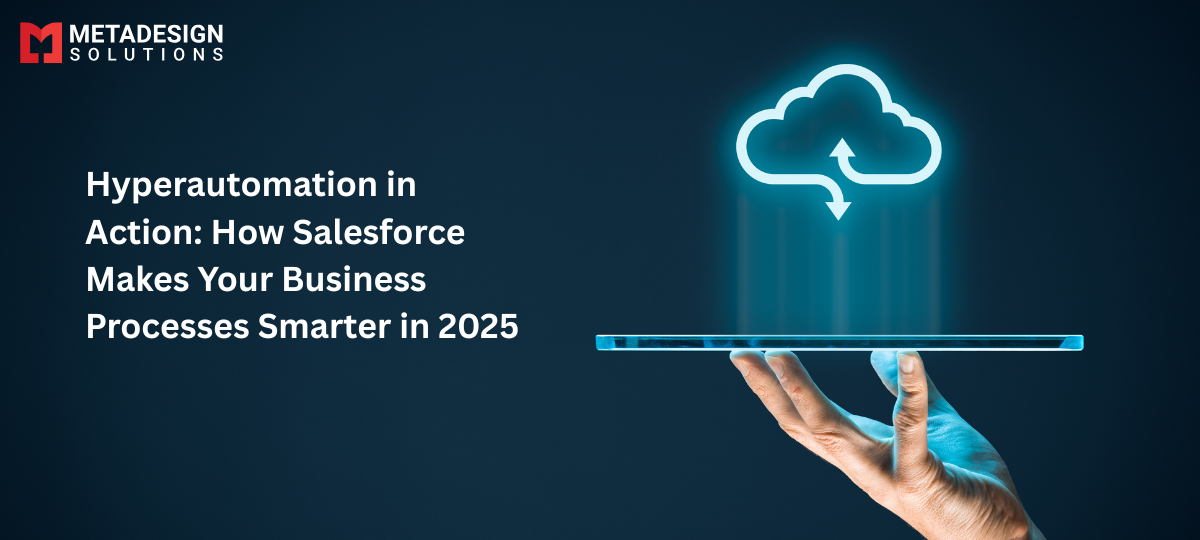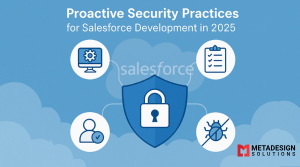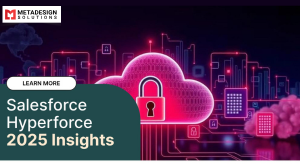Introduction
As organizations strive to keep pace with the digital-first economy, the pressure to automate complex business processes has intensified. In 2025, hyperautomation is not a buzzword—it’s a strategic imperative. Salesforce, with its vast ecosystem, is empowering businesses to automate beyond basic workflows by integrating AI, low-code tools, DevOps pipelines, and enterprise resource planning (ERP) systems.
This blog explores how Salesforce is at the forefront of hyperautomation in 2025. We’ll break down its key components—from intelligent process automation and custom AI models to CI/CD pipelines and seamless SAP/ERP integration—backed by real-world scenarios and use cases.
What Is Hyperautomation?
Hyperautomation is the coordinated use of AI, machine learning (ML), robotic process automation (RPA), and integration tools to rapidly identify and automate as many business processes as possible.
In Salesforce, hyperautomation includes:
- Automating sales and service workflows
- Predicting customer behavior using AI
- Deploying flows with zero human intervention
- Orchestrating multi-platform data from SAP, ERP, and marketing tools
Unlock the Power of Hyperautomation with Salesforce!
Discover how Salesforce can transform your business processes with AI and automation. Contact us today to implement smarter, more efficient solutions for 2025 and beyond!
1. Apex and Einstein: The AI + Automation Duo
Salesforce Apex, the proprietary programming language of Salesforce, has become even more powerful in 2025 when paired with Einstein AI. Custom AI agents, built using Apex logic and Einstein GPT, are automating entire customer journeys.
Example: Apex-triggered Smart Case Routing
trigger AutoAssignCase on Case (before insert) {
for (Case c : Trigger.new) {
if (c.Subject.contains('Payment Issue')) {
c.OwnerId = '0051U000007xxxx'; // Assign to Billing Team
}
}
}
Read more on the language behind Salesforce automation in our blog comparing Salesforce Apex vs. C# for enterprise programming.
2. Process Builder, Flow, and Mulesoft for Intelligent Workflow Orchestration
In 2025, Flow Builder is the command center for low-code hyperautomation in Salesforce. Combined with MuleSoft, Salesforce Flow can orchestrate actions across platforms like SAP, Oracle, Workday, and custom APIs.
Use Case: Order Fulfillment with SAP
- Salesforce Flow listens to a closed opportunity
- MuleSoft passes data to SAP ERP
- SAP triggers delivery creation
- Status updates return to Salesforce for customer notifications
Dive deeper into how Salesforce integrates with ERP, marketing, and business systems.
3. DevOps & CI/CD: Accelerating Automation Rollouts
Salesforce teams are no longer waiting weeks to push updates. Thanks to Salesforce DevOps Center, GitHub, and CI/CD pipelines, new automation rules and Flows are shipped daily without downtime.
DevOps Pipeline Flow:
- Developer creates Flow in sandbox
- Code committed to GitHub via DevOps Center
- Jenkins pipeline deploys to staging
- Automated tests validate changes
- Changes promoted to production
Want to streamline your own delivery pipelines? Learn how from our guide on Salesforce CI/CD using DevOps Center.
4. Einstein GPT + AI-Powered Agents
Einstein GPT is now embedded into every Salesforce Cloud product. It can:
- Generate personalized emails at scale
- Summarize meeting transcripts
- Score leads with dynamic AI models
- Auto-draft knowledge articles from cases
Scenario: Service Agent Copilot
A support agent views a customer case. Einstein GPT suggests a resolution article, generates a response email, and schedules a follow-up in one click—saving 20 minutes per ticket.
5. Integration with SAP: Breaking Down Silos
2025’s hyperautomation demands real-time, bidirectional integration. With Salesforce + MuleSoft, companies integrate Salesforce Sales/Service Cloud with SAP S/4HANA to:
- Sync product pricing, inventory, and order statuses
- Enable customer reps to view real-time ERP data in Salesforce
- Trigger SAP workflows from Salesforce cases
See our detailed walkthrough on Salesforce + SAP integration for enterprise transformation.
6. Real-Time Hyperautomation Across Touchpoints
Salesforce’s architecture in 2025 is built to deliver:
- Event-driven workflows: Using Platform Events + CometD
- Bot integrations: Service bots using Einstein Chat and Flow
- Real-time decisions: Next-best-action powered by AI
- Cross-cloud automations: Syncing Marketing Cloud, Commerce Cloud, and Service Cloud flows
Event-Driven Architecture Example
PlatformEvent pe = new PlatformEvent();
pe.OrderId = '12345';
pe.Status = 'Shipped';
pe.publish();
7. Governance, Security & Scalability
As automation spreads, maintaining control is crucial. Salesforce offers:
- Named credentials and JWT OAuth flows for secure integrations
- Change sets and unlocked packages for modular deployment
- Custom metadata types for versioned configuration
- Shield encryption and audit trails
8. Real-World Impact of Hyperautomation
Companies embracing Salesforce hyperautomation in 2025 are seeing:
- 45% reduction in manual tasks via Flow automation
- 60% faster deployment cycles with DevOps Center
- 3x faster customer service resolution via Einstein GPT
- 2x increase in marketing campaign efficiency with real-time data sync
Conclusion
Hyperautomation is no longer experimental. It is a business-critical capability that enables organizations to stay competitive. With Salesforce, companies in 2025 are not only automating tasks but also unlocking predictive insights, personalized experiences, and enterprise-wide orchestration.
Unlock the Power of Hyperautomation with Salesforce Development Services! Whether you’re integrating ERP systems like SAP, accelerating CI/CD with DevOps, or building AI copilots with Apex and Einstein GPT, Salesforce is your launchpad for hyperautomation. Contact us today to implement smarter, more efficient solutions for 2025 and beyond!
Related Hashtags:
#FullStackDevelopment #CloudComputing #AIInDevelopment #RealTimeCollaboration #CloudNative #MachineLearning #DevTools #DeveloperCollaboration #HybridTechStacks #LowCode #AIIntegration #ContinuousLearning #TechTrends #FutureOfDevelopment #AIandCloud #DeveloperProductivity #FullStackFuture



